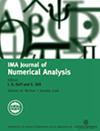可变数据的自适应VEM:收敛性和最优性
IF 2.3
2区 数学
Q1 MATHEMATICS, APPLIED
引用次数: 0
摘要
本文设计了一种最低阶自适应虚元法(AVEM),将二维三角形网格作为多边形处理。AVEM依赖于最近在beir本文章由计算机程序翻译,如有差异,请以英文原文为准。
Adaptive VEM for variable data: convergence and optimality
We design an adaptive virtual element method (AVEM) of lowest order over triangular meshes with hanging nodes in 2d, which are treated as polygons. AVEM hinges on the stabilization-free a posteriori error estimators recently derived in Beirão da Veiga et al. (2023, Adaptive VEM: stabilization-free a posteriori error analysis and contraction property. SIAM J. Numer. Anal., 61, 457–494). The crucial property, which also plays a central role in this paper, is that the stabilization term can be made arbitrarily small relative to the a posteriori error estimators upon increasing the stabilization parameter. Our AVEM concatenates two modules, GALERKIN and DATA. The former deals with piecewise constant data and is shown in the above article to be a contraction between consecutive iterates. The latter approximates general data by piecewise constants to a desired accuracy. AVEM is shown to be convergent and quasi-optimal, in terms of error decay versus degrees of freedom, for solutions and data belonging to appropriate approximation classes. Numerical experiments illustrate the interplay between these two modules and provide computational evidence of optimality.
求助全文
通过发布文献求助,成功后即可免费获取论文全文。
去求助
来源期刊
CiteScore
5.30
自引率
4.80%
发文量
79
审稿时长
6-12 weeks
期刊介绍:
The IMA Journal of Numerical Analysis (IMAJNA) publishes original contributions to all fields of numerical analysis; articles will be accepted which treat the theory, development or use of practical algorithms and interactions between these aspects. Occasional survey articles are also published.

 求助内容:
求助内容: 应助结果提醒方式:
应助结果提醒方式:


